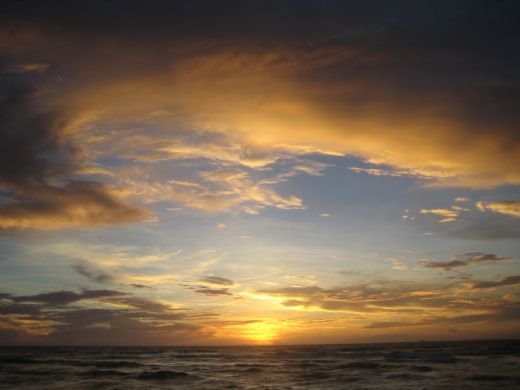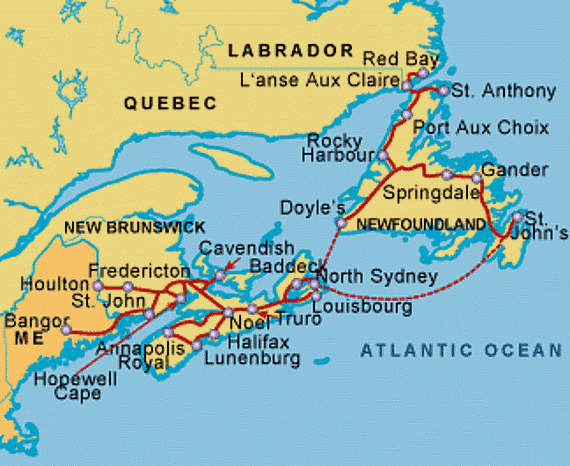June 17, 2008
We’re now off along the
Two people, two dogs and a cat in a 31-foot motorhome for 3 months?!!! Driving ~10,000 miles at 8 miles per gallon with today's gas prices?!!! many people would think we're crazy but for us this is the ONLY way to travel. We survived a trip through Western Canada and Alaska last summer. So, this time we're off to the East Coast and the Maritime Provinces of Canada.


June 17, 2008
We’re now off along the
June 13, Friday
We left
The campground is along a pretty creek. We were parked nose to the bank so we had a full-screen view of a gently rippling green ribbon of water.
June 11, Wednesday
June 9, Monday
June 8, Sunday
This was a travel day across
We stopped at a small private campground just west of
June 7, Saturday
Our descent into the new entrance was peculiar, to say the least. A path through the woods leads to an open area and a large, locked metal door set into the side of a sinkhole. Through the door, we descended many steps into a large, dry passageway. In several places, water from above dripped on us and ran down the cave walls. After about two miles of passage and many ramps and steps, we reached the star attraction of this part of the cave. The Frozen Niagara formation is one of the few examples of flowstone in the cave. This is the only public area with stalactites and stalagmites. It was distressing to see how many were broken. Over a hundred years of tourism during private ownership certainly took its toll. (We were stuck by the contrast with Kartchner Caverns, in a state park near
The cave is 54 degrees and the air temperature was at least a very humid 90 degrees! What a contrast! We quickly were covered in sweat and found it hard to breathe. When we got back to the coach, we HAD to turn on the generator and air conditioning to cool down again. All the park staff complained about the unseasonable heat which has followed us across the country.
This morning we took our final cave tour, the Historical Tour using the historic entrance. We retraced a little of the same path as our first tour, as far as the saltpeter mill works, then turned off to a different part of the cave. We followed passages discovered and named by Stephen Bishop, a black slave tour guide of the 1830’s – 50’s. He reportedly crossed Bottomless Pit after laying down a log and shimmying along it over a huge chasm. We walked across on a metal bridge. We entered at the bottom of Mammoth Dome then climbed 249 steps to exit near the top of the chamber, a feat impossible in historic tours. There were many examples of historic graffiti, names and inscriptions made by candle smoke on the cave ceiling. One passage, River Walk, occasionally floods during wet springs and had damp soil underfoot; the guide said that last month it held 5 feet of water and has been completely flooded with up to 12 feet at times. One passage is named Tall Man’s Misery – we had several hundred feet of low ceiling that we had to stoop-walk under. Another passage is Fat Man’s Misery, a narrow twisty passage formed by fast-moving water.
After finishing the tour, we broke camp and drove across
June 6, Friday
We crossed
Last night we went on our first tour, by lantern light, to the Star Chamber. This room got its name in the earliest days of tourism at
This morning, a wild turkey and a white-tail doe strolled through camp without any notice of or concern for the dogs and us. They must know that they’re protected in the National Park. This afternoon, we’ll tour another deeper and wetter park of the cave, using the “New Entrance” deliberately created when an early cave entrepreneur dropped 26 sticks of dynamite down a sink hole.
49 Day Canadian Maritimes Tour with Adventure Caravans
Get Acquainted Orientation and Party
Welcome Dinner
Longest Covered Bridge
(77 miles)
Tour King's Landing
Walking Tour
7/2, 3 DAY 5, 6
(132 miles)
Barbeque Hamburger Feast
Fundy National Park
"Flower Pots" Rock Formations
Hopewell Cape Record Tides Visit
7/4-7 DAY 7 - 10 CAVENDISH, PEI
Confederation Bridge Tolls to
Tour Anne of Green Gables Home
New
Lunch at Famous PEI Preserve Company
Lobster Fishing Demonstration
"World Famous" Lobster Dinner on the Wharf
Anne of Green Gables Live Stage Play
7/8-7/9 DAY 11 - 12
Dinner Prepared by Local
Tidal
Tidal Bore Visit
Optional Tidal Bore Rafting Trip
7/10-11 DAY 13 - 14
"Grand-Pre" National Park
Royal Historical Botanical Gardens; Lunch
7/12-13 DAY 15 - 16 LUNENBURG, NS
Optional: Bluenose Tour (If Available)
7/14-16 DAY 17 - 19 HALIFAX-
Guided Historic City Tour
Titanic Memorial & Burial Grounds
Historic Buildings & Stone Fortress
Citadel National Historic Park
Peggy's Cove Tour (Lunch)
Staff Hosted Breakfast
7/17-18 DAY 20 - 21 BADDECK, NS
Cabot Trail Tour; Lunch
Joe's Scarecrow Exhibit
Village of Cheticamp & Celtic Lodge
7/19-20 DAY 22 - 23
North Sydney Lobster Dinner Party on Wharf
7/21 DAY 24 ARGENTIA, NFLD
Ferry To
7/22-24 DAY 25 - 27
Signal Hill, Site of Marconi's First Transatlantic Message
Signal Hill International Tattoo
Lunch at "My Brother's Place"
NCR Institute for Ocean Technology
7/25-26 DAY 28 - 29
Steak Barbecue Dinner
Authentic Newfie Breakfast
Silent Witness Memorial
7/27-29 DAY 30 - 32 TWILLINGATE, NFLD
Private Newfie Dinner Prepared by Locals
Durrell Fishing Stage Guided Tour
Historic Long Point Lighthouse
Whale Watching & Scenic Boat Cruise
"Split Peas" Live Local Musical Performance
7/30-31 DAY 33 - 34
Guided
Dinner Prepared by Locals
"Newfie Screech-In" Ceremony & "Newfie Time"
Fresh Cooked Mussels; Lunch by Locals
Women's Institute,
King's Point Pottery Demonstration
Rattling
Tour L' Anse Aux Meadows Historic Site
Grenfell Experience & Famous Jordi Bonet Murals
St. Anthony Lighhtouse & Waterfront
"Viking Feast" Dinner in a Viking Long House
8/6 DAY 40
8/7 DAY 41 L'ANSE AUX CLAIR, LAB
Passenger Ferry from St Barbe to
Round Trip Transfers to Northern Lights Hotel
Hotel Accommodations (1 Night)
Tour of Red Bay Labrador Straits
Point Amour Lighthouse & Ancient Burial Site
Labrador
8/8 DAY 42 DEER
Passenger Ferry to St Barbe from
8/9 DAY 43 GRAND CODROY, NFLD
8/10-11 DAY 44 - 45 LOUISBOURG, NS
Ferry Crossing to
Tour Fortress at Louisbourg
Louisbourg Playhouse (Live Ceilidh Entertainment)
8/12 DAY 46
8/13-14 DAY 47 - 48
Reversing Falls
Farewell Dinner Party at "Reversing
8/15 DAY 49
8/16 Leave for Home
(3200 miles)